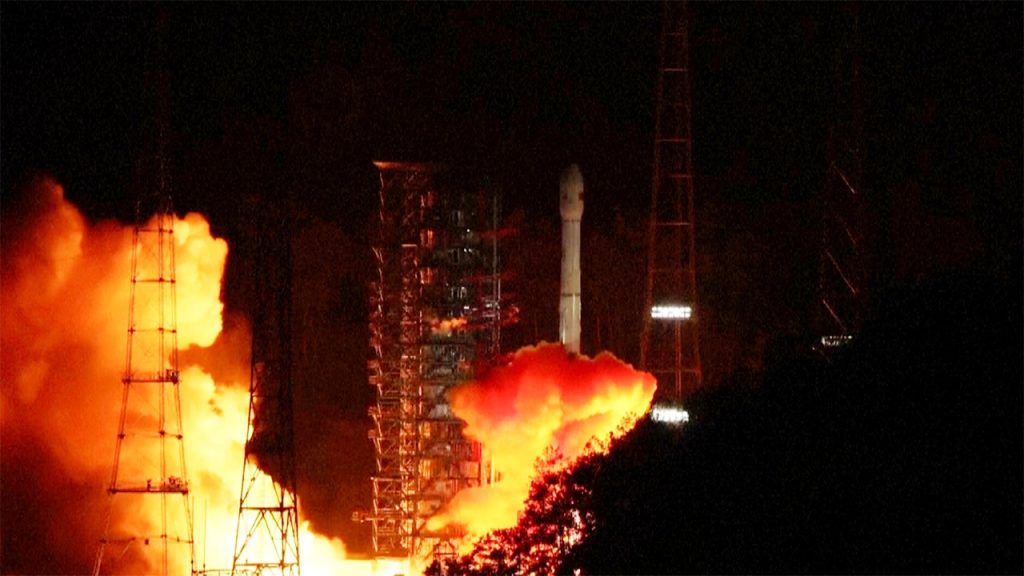China has successfully launched its Tianwen-2 space probe, aimed at exploring the asteroid known as 2016 HO3, or 469219 Kamoʻoalewa. This mission is part of China’s broader ambitions in space exploration and is expected to provide valuable samples that could advance our understanding of the formation of Earth. The launch took place from the Xichang Satellite Launch Center in Sichuan Province, marking a significant step in China’s ongoing quest for interplanetary exploration.
| Article Subheadings |
|---|
| 1) Overview of the Tianwen-2 Mission |
| 2) Future Plans for China’s Space Exploration |
| 3) The Significance of Asteroid 2016 HO3 |
| 4) International Implications of the Mission |
| 5) China’s Current Space Capabilities |
Overview of the Tianwen-2 Mission
The Tianwen-2 probe was launched on a Long March 3-B rocket from the Xichang Satellite Launch Center in Sichuan Province. The mission’s primary objective is to send the probe to asteroid 2016 HO3, where it will collect samples and return them to Earth. The China National Space Administration (CNSA) described this launch as a pivotal step in their long-term goals for space exploration. The Tianwen-2 mission marks a departure from its predecessor, Tianwen-1, which successfully landed on Mars and collected significant data.
This mission is not only ambitious but also reflects China’s strategic focus on advancing its space capabilities. Control of this probe falls under the jurisdiction of the CNSA, which emphasizes the importance of this endeavor in the context of international space exploration competition.
Future Plans for China’s Space Exploration
Plans for China’s future in space exploration extend beyond just the Tianwen-2 mission. Zhang Rongqiao, the chief designer of the Tianwen-1 mission, has laid out a roadmap that includes the ambitious Tianwen-3 mission, which aims to return samples from Mars by 2028. Another venture, Tianwen-4, is set to target Jupiter. This long-term strategy showcases China’s intention to solidify its position as a global leader in space exploration.
The proposed ten-year plan involves various missions to different celestial bodies, a sign that China is gearing up for extensive research and exploration. The CNSA’s systematic approach in planning these missions reflects a robust investment in science and technology, emphasizing the significance of their objectives in the wider context of global exploration efforts.
The Significance of Asteroid 2016 HO3
Asteroid 2016 HO3, an object of interest for the Tianwen-2 mission, is noted for its relatively stable orbit around Earth. Scientists believe that studying this asteroid could provide critical insights into the early solar system and the origins of water on Earth. Such information is essential for understanding both planetary formation and the conditions necessary for life as we know it.
Understanding the composition of 2016 HO3 will help researchers unravel the complex history of Earth’s formation and the dynamic processes of celestial bodies. The anticipated return of samples from this mission, scheduled to be completed in about two years, could also open the door to further scientific collaborations and advancements.
International Implications of the Mission
The Tianwen-2 mission comes with significant implications for international relations in the realm of space exploration. While the CNSA plans to share samples with international partners as has been done in previous missions, the Wolf Amendment, enacted by the U.S. Congress in 2011, prohibits any collaboration between NASA and the CNSA. This law illustrates the complexities of U.S.-China relations, especially concerning space activities.
As China continues to advance its space capabilities, any findings from the Tianwen-2 mission will likely be monitored closely by global powers, notably the U.S. This growing rivalry in space exploration raises questions about future collaborations and the possibility of shared knowledge concerning space science.
China’s Current Space Capabilities
China’s capabilities in space exploration are bolstered by its operational three-person Tiangong space station, also known as the “Heavenly Palace.” Established following exclusion from the International Space Station due to U.S. national security concerns, the Tiangong space station marks a significant achievement in China’s manned spaceflight technology. The mission signifies China’s intention to become a major player in the realm of space exploration.
With its continued investment in space technology and missions, China’s ambitions are expected to position the country as a formidable force in the future of space research. The Tianwen-2 mission is just one illustration of a broader commitment to advancing human knowledge and technology in outer space.
| No. | Key Points |
|---|---|
| 1 | China successfully launched the Tianwen-2 probe to explore asteroid 2016 HO3. |
| 2 | The mission will collect samples to gain insights into the origins of Earth and water. |
| 3 | Zhang Rongqiao outlines a ten-year plan featuring additional missions, including Tianwen-3 and Tianwen-4. |
| 4 | The mission raises questions about international collaboration, particularly with the U.S. due to the Wolf Amendment. |
| 5 | China’s space station, Tiangong, showcases its growing capabilities in space exploration. |
Summary
The launch of the Tianwen-2 probe underscores China’s ambitions in space exploration, particularly its intention to further its research on asteroids that could yield valuable information about Earth’s formation. With a long-term strategy in place for future missions, China is poised to solidify its role as a leading force in astrophysical research. This endeavor also raises significant questions about international cooperation and competition in space, especially concerning U.S. policies that may restrict collaborative efforts.
Frequently Asked Questions
Question: What is the Tianwen-2 mission’s primary goal?
The primary goal of the Tianwen-2 mission is to explore asteroid 2016 HO3 and collect samples that may provide insights into Earth’s formation and the origins of water.
Question: How does Tianwen-2 differ from its predecessor, Tianwen-1?
While Tianwen-1 focused on Mars exploration and successfully landed on the planet, Tianwen-2 is aimed at an asteroid, expanding China’s exploration objectives within the solar system.
Question: What are the future plans for China’s space exploration?
China has laid out a ten-year plan that includes missions like Tianwen-3, which aims to return samples from Mars, and Tianwen-4, which will target Jupiter.
